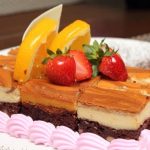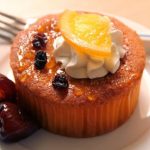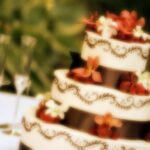Decorating a cake is not just about adding a few sprinkles or a dollop of frosting – it’s an art form that can transform a simple cake into a stunning masterpiece. In this article, we will explore the world of cake decoration and discover how to make decoration of cake truly shine. With the right tools, ingredients, and techniques, you can elevate your cakes to new heights and impress your friends and family with your creative skills.
The importance of cake decoration goes beyond just aesthetics – it can make a statement at any celebration and show off your personality and style. Whether you’re decorating a birthday cake, wedding cake, or just a special treat for yourself, the way you adorn your cake can set the tone for the entire event. From elegant designs to whimsical creations, there are endless possibilities when it comes to decorating a cake.
In this comprehensive guide, we will cover everything from essential tools and ingredients needed for successful cake decoration to basic techniques like piping and fondant work. We’ll also delve into more advanced methods such as sugar paste modeling and airbrushing for those looking to take their decorating skills to the next level.
Whether you’re a beginner just starting out or an experienced baker looking for fresh inspiration, this article will provide you with the knowledge and confidence to create beautiful decorations for all your cakes.
Essential Tools and Ingredients
When it comes to cake decoration, having the right tools and ingredients is crucial to achieving professional-looking results. Whether you’re a beginner or an experienced baker, having a well-stocked decorating kit can make all the difference in creating impressive cakes. Here, we will discuss some essential tools and ingredients needed to decorate a cake like a pro.
Tools
One of the most important tools for cake decoration is a good set of piping tips and bags. These are essential for creating intricate designs, borders, and writing on cakes. Other basic tools include offset spatulas for smooth frosting application, a turntable for easy decorating, and a bench scraper for clean edges. Additionally, investing in quality food coloring gels, edible glitter, and moldable sugar paste can expand your decorating possibilities.
Ingredients
In addition to basic baking ingredients like flour, sugar, butter, and eggs, there are specific ingredients that are essential for cake decoration. For instance, royal icing is commonly used for detailed piped designs and decorations that need to harden.
Fondant is another versatile ingredient that can be rolled out to cover cakes or shaped into decorative elements. And let’s not forget about buttercream frosting – it’s not only delicious but also perfect for creating smooth finishes and textured decorations on cakes.
Storage and Organization
To ensure that your tools and ingredients are always ready when you need them, proper storage and organization are key. Invest in containers for storing piping tips, food coloring gels, and edible decorations so they stay fresh and easily accessible. Keep your fondant wrapped tightly in plastic wrap to prevent it from drying out. By keeping your tools and ingredients organized, you’ll be able to focus on the creative process of cake decoration without any unnecessary stress.
Choosing the Right Cake
When it comes to cake decoration, choosing the right type of cake is crucial for a successful outcome. Different cakes have varying textures, flavors, and structures that can impact how well they hold up to decorating techniques. Here are some tips on selecting the best type of cake for your decoration project and how to prepare it for the decorating process:
- Consider the Moisture Level: Moist cakes like sponge or chiffon are great choices for decorations that involve soaking syrups or fillings. However, if you plan on using intricate fondant work, a firmer cake like butter cake may be more suitable.
- Structural Integrity: Sturdy cakes such as pound cake or carrot cake are ideal for stacked or tiered cakes that require additional support. They can withstand the weight of decorations and icing without collapsing.
- Flavor Compatibility: Think about how your chosen cake flavor will complement the decorations you plan to add. For example, a rich chocolate cake may overpower delicate floral decorations, while a vanilla sponge provides a versatile base for various designs.
Once you have selected the perfect cake base for your decoration project, it’s essential to prepare it properly before starting the decorating process. Here are some steps to ensure your cake is ready for embellishment:
- Cooling Time: Allow your baked cake to cool completely before attempting any decoration work. Warm cakes can cause icings and fillings to melt or slide off, ruining your design.
- Leveling and Trimming: Use a sharp knife or cake leveler to trim off any uneven tops or edges from your cake layers. This creates a smooth surface for decorating and prevents lopsided decorations.
- Frosting Base: Applying a thin layer of crumb coat frosting can help seal in crumbs and provide a smooth foundation for your final decoration layer. This step ensures that your decorations adhere securely to the cake surface.
By carefully considering the type of cake you use and properly preparing it for decoration, you set yourself up for success in creating stunning cakes that not only look beautiful but taste delicious as well. Remember, the right cake choice and preparation method play a significant role in achieving professional-looking results in your decorating endeavors.
Basic Decoration Techniques
Decorating a cake is not just about making it look visually appealing but also about adding a personal touch and creativity to your baked masterpiece. In this section, we will explore some basic decoration techniques that can help elevate your cake decorating skills to the next level. Whether you are a beginner or looking to brush up on your skills, mastering these simple yet effective techniques such as piping, fondant work, and buttercream flowers will make your cakes stand out.
Piping is a versatile decoration technique that involves using a piping bag with various tips to create different designs on the cake’s surface. From intricate lace patterns to writing messages, piping allows for endless possibilities in cake decoration. To start piping, ensure that your frosting is at the right consistency – not too thick or thin.
Practice with different piping tips to create swirls, dots, lines, and other decorative elements on your cake. Remember to apply consistent pressure when piping for even and smooth decorations.
Fondant work is another popular method of decorating cakes that involves rolling out a sugar-based paste into thin sheets and covering the cake with it. Fondant provides a smooth canvas for creating custom designs, shapes, and 3D decorations on cakes.
To work with fondant successfully, knead it until pliable, roll it out evenly using a rolling pin dusted with powdered sugar, then drape it over the cake gently to prevent tears or creases. Use fondant tools like cutters, molds, and sculpting tools to craft beautiful details for your cake design.
Buttercream flowers are elegant embellishments that can add a touch of beauty and sophistication to any cake. Using buttercream frosting in various colors and consistency levels, pipe delicate petals onto the cake surface to create lifelike floral decorations. Begin by practicing basic flower shapes like roses or daisies before moving on to more intricate designs like peonies or orchids.
Layer different petal shapes and colors to achieve a realistic flower effect on your cakes. With practice and patience, you can master the art of buttercream flower piping and impress your guests with stunning floral arrangements on your cakes.
| Decoration Technique | Description |
|---|---|
| Piping | Using a piping bag with various tips to create designs on the cake’s surface. |
| Fondant Work | Rolling out sugar-based paste into thin sheets for creating custom designs on cakes. |
| Buttercream Flowers | Using buttercream frosting in various colors and consistencies to pipe lifelike floral decorations. |
Advanced Decoration Techniques
When it comes to taking cake decoration to the next level, advanced techniques like sugar paste modeling, airbrushing, and edible painting can truly elevate your creations. These methods allow for intricate detailing and personalized touches that will make your cakes stand out at any event or celebration. Here’s a closer look at how you can master these advanced decoration techniques.
To create stunning sugar paste models to adorn your cakes, you’ll need some essential tools such as modeling tools, shaping molds, and edible colors. Start by kneading the sugar paste until it’s pliable and then use your creativity to shape it into figures, flowers, or intricate designs. With practice and patience, you can sculpt intricate details that will bring your cake to life.
Airbrushing is another technique that adds depth and dimension to cake decorations. With an airbrush machine and edible colors, you can create gradient effects, shadows, and highlights on your cakes. Practice controlling the airbrush pressure and distance to achieve different effects. From ombre backgrounds to intricate stenciling designs, airbrushing opens up a world of possibilities for decorating cakes in unique ways.
Edible painting is a versatile technique that allows you to add detailed designs and images directly onto your cakes using food-safe colors. Invest in quality brushes specifically designed for food decorating and explore different painting techniques like wet-on-wet or dry brushing. Whether you’re creating watercolor accents or intricate patterns, edible painting gives you the freedom to showcase your artistic skills on edible canvases.
With these advanced decoration techniques in your repertoire, you can take your cake decorating skills to new heights. Experiment with sugar paste modeling, airbrushing, and edible painting to add a touch of artistry and creativity to your cakes.
Remember that practice makes perfect, so don’t be afraid to try new techniques and push the boundaries of traditional cake decoration methods. Let your imagination run wild as you explore the endless possibilities of making beautiful cake decorations come alive on your baked creations.
Tips and Tricks for Beginners
As a beginner in the world of cake decoration, it can be overwhelming to know where to start. However, with the right tips and tricks, you can avoid common mistakes and achieve professional-looking results that will impress your friends and family. Here are some helpful suggestions on how to make decoration of cake successful:
Start With the Basics
Before diving into intricate designs and techniques, it’s essential to master the basics of cake decoration. Practice simple piping techniques, like creating borders or writing messages on cakes, using a piping bag and different nozzles. Get comfortable working with buttercream or royal icing to understand their consistency and how they hold shape when decorating.
Use Quality Ingredients
One key aspect of successful cake decoration is using quality ingredients. Invest in good quality fondant, food coloring, edible decorations, and flavor extracts for the best results. Fresh ingredients will not only enhance the taste of your cake but also make it easier to work with when decorating. Remember that the quality of your decorations also depends on the materials you use.
Take Your Time
Patience is crucial when it comes to cake decoration. Rushing through the process can lead to sloppy results and mistakes that could have been easily avoided. Take your time to plan out your design, practice new techniques before applying them to your final cake, and allow yourself enough time to execute your ideas flawlessly. Remember, precision and attention to detail are key in achieving professional-looking cake decorations.
By following these tips for beginners in cake decoration, you’ll be on your way to creating stunning cakes that look as good as they taste. Don’t be afraid to experiment with different techniques, colors, and designs to find your unique style in cake decorating. With practice and dedication, you’ll soon be able to create beautiful works of art that will wow anyone who sees them.
Inspiration and Ideas
When it comes to cake decoration, the possibilities are truly endless. Whether you are a seasoned pro or just starting out on your baking journey, finding inspiration and ideas for your cake decorations can be a game-changer. Creativity knows no bounds in the world of cake decorating, and with the right sources of inspiration, you can turn a simple cake into a masterpiece that will wow your friends and family.
To start, consider browsing through social media platforms like Instagram and Pinterest for a wealth of creative cake decoration ideas. From intricate floral designs to whimsical cartoon characters, there is no shortage of amazing creations to spark your imagination. You can also look for inspiration in magazines, baking books, or even by attending cake decoration workshops or classes in your area.
Themes play a significant role in cake decoration, as they provide a cohesive vision for your design. Whether you are planning a birthday party, wedding celebration, or holiday gathering, incorporating a theme into your cake decoration can tie everything together beautifully. Some popular themes include vintage elegance, rustic charm, modern minimalism, or extravagant opulence. By choosing a theme that resonates with the occasion or the recipient’s preferences, you can create a stunning cake that is sure to impress.
Remember that trends in cake decoration are constantly evolving, so staying up-to-date with the latest styles and techniques can give your creations a fresh and contemporary appeal. For example, drip cakes, geode cakes, naked cakes, and mirror glaze cakes have been trending in recent years, adding unique touches to traditional cake designs.
Experimenting with new trends and putting your own spin on them can set your creations apart and showcase your skills as a decorator. With an open mind and a passion for creativity, the sky’s the limit on how to make decoration of cake.
Troubleshooting Guide
One common issue that individuals encounter when learning how to make decoration of cake is air bubbles forming in their icing or fondant. These unsightly bubbles can disrupt the smooth finish of a cake and affect the overall presentation. To prevent air bubbles, it is essential to knead your fondant thoroughly before rolling it out.
Additionally, when applying fondant to your cake, gently smooth it out with a fondant smoother or your hands to eliminate any trapped air. If air bubbles still appear, use a small pin to prick them and gently press the air out.
Another challenge that cake decorators often face is achieving vibrant colors in their decorations, especially when using buttercream frosting. To create bold and vivid hues, consider using gel food coloring instead of liquid food coloring. Gel colors are more concentrated and will not water down your frosting or icing.
Start by adding a small amount of gel color and gradually increase until you achieve the desired shade. Remember that colors deepen over time, so allow the frosting to rest for a while before adjusting if needed.
Furthermore, a common issue encountered by beginners in cake decoration is cracked or dry fondant when covering a cake. This can be frustrating as it affects the aesthetics of the finished product. To avoid this problem, ensure that your fondant is rolled out to an even thickness before draping it over the cake.
Cracking may occur if the fondant is too thick or if it dries out quickly while working with it. You can prevent dryness by kneading some shortening into the fondant or covering it with plastic wrap when not in use to retain moisture.
| Common Issue | Solution |
|---|---|
| Air bubbles in icing or fondant | Knead fondant thoroughly and use a pin to release trapped air |
| Dull colors in buttercream frosting | Use gel food coloring for more vibrant hues and allow colors to deepen over time |
| Cracked or dry fondant | Roll out fondant evenly, knead with shortening, cover when not in use to retain moisture |
Conclusion
In conclusion, mastering the art of cake decoration is a rewarding and creative skill that can transform a simple cake into a show-stopping masterpiece. By following the essential tools and ingredients required, along with choosing the right cake base and learning basic and advanced decoration techniques like piping, fondant work, and sugar paste modeling, anyone can elevate their baking game to the next level.
The key lies in practice, patience, and a willingness to experiment with different techniques to discover what works best for each unique creation.
For beginners embarking on their cake decorating journey, it is important to remember that mistakes are part of the learning process. With the tips and tricks provided in this article, aspiring decorators can avoid common pitfalls and achieve professional-looking results. Additionally, drawing inspiration from creative ideas, themes, and trends highlighted here can spark new ideas and help individuals develop their own signature style in cake decoration.
Ultimately, the world of cake decoration offers endless possibilities for creativity and innovation. Whether it’s for birthdays, weddings, or any other special occasion, putting your heart into creating beautiful cake decorations not only brings joy to others but also allows you to express your artistic flair.
So don’t be afraid to experiment, push boundaries, and unleash your creativity in making stunning cake decorations that will leave everyone amazed. Remember: the only limit is your imagination when it comes to turning ordinary cakes into extraordinary works of edible art.
Frequently Asked Questions
How to Make Cake Decorating Items?
Making cake decorating items requires creativity and precision. You can create items like fondant shapes, buttercream flowers, or edible decorations using molds, cutters, and food coloring. It’s important to practice and experiment with different techniques to perfect your skills.
How to Make a Cake Good for Decorating?
To make a cake good for decorating, it’s essential to start with a sturdy and well-baked base. Using a dense cake recipe like pound cake or sponge cake can provide the stability needed for intricate decorations. Make sure the cake is completely cooled before frosting to prevent any melting or sliding of decorations.
What Are the Steps in Cake Decoration?
The steps in cake decoration typically involve preparing the cake surface by leveling and crumb coating it with frosting. Then, you can apply the final layer of frosting smoothly using a spatula or piping bag. After that, you can add details like borders, flowers, or writing with various decorating techniques such as piping, sculpting fondant, or painting with food colors.
Finally, adding finishing touches like sprinkles or edible glitter can enhance the overall look of the cake. Practice and patience are key to mastering each step in cake decoration.

Welcome to my blog about home and family. This blog is a place where I will share my thoughts, ideas, and experiences related to these important topics. I am a stay-at-home mom with two young children. I hope you enjoy reading it! and may find some helpful tips and ideas that will make your home and family life even better!





